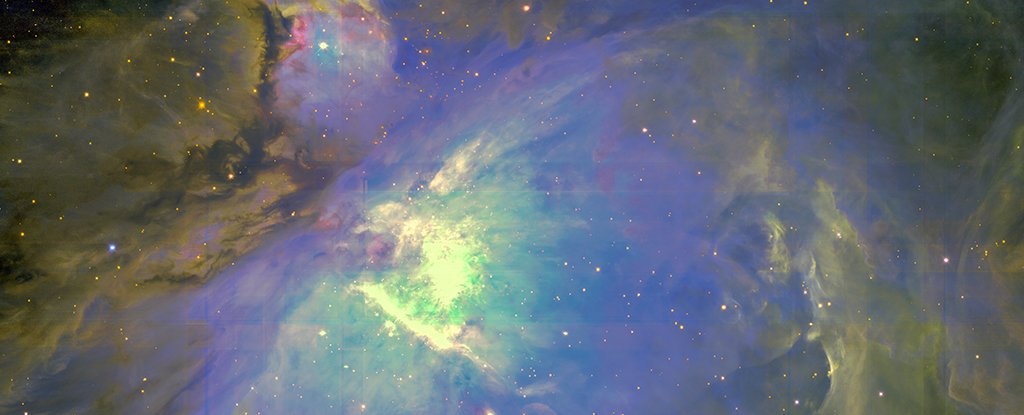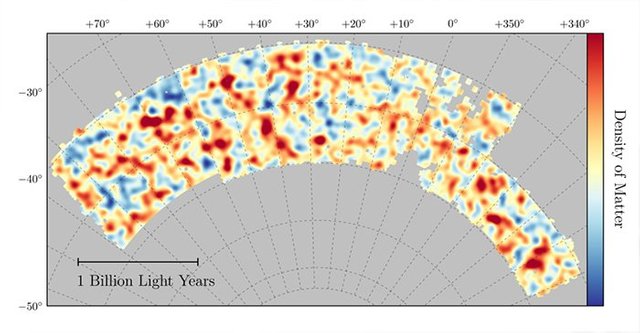
New research conducted as a part of the ongoing Dark Energy Survey (DES) has used the way mass distorts light to produce a bigger, more highly detailed map of the Universe's dark matter structure.
Not only do the measurements support the view that about 26 percent of the Universe is made up of the mysterious stuff, it's turned out that its distribution is a little smoother than had been estimated, which if confirmed could hint at undiscovered physics.
Since 2013, the international team behind the DES has been carrying out a deep, wide-area scan of about 1/8th of the night sky in an effort to collect data on some 300 million galaxies billions of light years from Earth, all to figure out what the hell this dark energy business is all about.
Dark energy and dark matter don't have much in common other than the fact they're both tight-lipped about their nature.
Dark energy is something of a black box that explains why the Universe seems to be accelerating in its expansion, an observation that has been broadly accepted now for at least two decades.
Whatever it is, it's no small deal, making up roughly 68 percent of the Universe's total energy.
On the other hand, dark matter is more about pulling stuff than pushing space apart. Just as mysterious, it's a black box that explains why galaxies hold together in spite of not seeming to have enough visible matter.
Knowing more about how the Universe spreads out over time, and how its matter clumps together, could reveal more about what exactly these things are. This requires knowing what everything looked like around 14 billion years ago when the Universe still had its baby-smooth skin, a feat that requires a camera that can look back in time.
Fortunately that's exactly what the Planck telescope can do. It provided just such a snapshot in the form of the Cosmic Microwave Background – a map of the radiation still humming through the Universe as an echo of its earliest days.
In 2015, DES released the first of its maps of the cosmos based on data from 2 million galaxies collected by its Dark Energy Camera, giving researchers a relatively more recent 'now' to compare with the 'then'.
Fast forward to today: we now have new map that's 10 times bigger, based on analysing the shapes of 26 million galaxies using gravitational lensing, a phenomenon predicted by Einstein's general relativity and first observed in 1919, launching the German born genius into the public spotlight.
Take a look at the fancy new map below.

Today we can use the fact that mass changes space to 'see' dark matter by measuring how light behind it distorts as it passes by, giving us a way to measure the amount and distribution of both kinds of matter across a portion of the Universe.
Comparing Planck's map with the one produced by the DES has supported the consensus on how much dark matter and dark energy there seems to be.
"The DES measurements, when compared with the Planck map, support the simplest version of the dark matter/dark energy theory," says researcher Joe Zuntz from the University of Edinburgh.
"The moment we realised that our measurement matched the Planck result within 7 percent was thrilling for the entire collaboration."
That 7 percent is close, but the fact it isn't exact could also be exciting for a whole other reason – if confirmed, the difference between the two results could mean that mass is clumping more slowly than current physics predicts, hinting at something undiscovered.
It's a fair bet that additional data will see the numbers draw more closely together in the future. Considering the results are also yet to be peer reviewed, all of the usual cautions apply.
But discoveries in astronomy often start with discrepancies such as this, so it's well worth a closer look.
"The Dark Energy Survey has already delivered some remarkable discoveries and measurements, and they have barely scratched the surface of their data," says Fermilab's director Nigel Lockyer.
"Today's world-leading results point forward to the great strides DES will make toward understanding dark energy in the coming years."
With another year to go and only 1/30th of the sky so far mapped, we look forward to an even bigger and better map in the near future.
The current results of the survey can be found on the DES website.!
Source:
http://www.sciencealert.com/this-is-the-most-detailed-map-yet-of-the-universe-s-dark-matter
Thanks@sagor24
Downvoting a post can decrease pending rewards and make it less visible. Common reasons:
Submit
welcome
Downvoting a post can decrease pending rewards and make it less visible. Common reasons:
Submit
Hi! I am a robot. I just upvoted you! I found similar content that readers might be interested in:
http://www.sciencealert.com/this-is-the-most-detailed-map-yet-of-the-universe-s-dark-matter
Downvoting a post can decrease pending rewards and make it less visible. Common reasons:
Submit